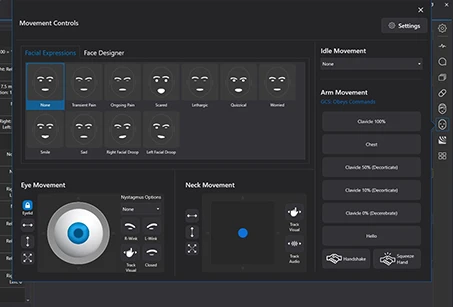Introducing
HAL®
S5301
Interdisciplinary
and Immersive
Meet the world’s most advanced interdisciplinary patient simulator
From emergency care to ICU and med-surg training, HAL is designed to fulfill educational objectives across clinical disciplines and blur the lines between simulation and real life. New lifelike motor movement, next-gen simulated physiology, UNI® 3, and many more industry-first capabilities launch the next leap in simulation.
Introducing
HAL®
S5301
Interdisciplinary
and Immersive
Introducing
HAL® S5301
Interdisciplinary and
Immersive
Meet the world’s most advanced interdisciplinary patient simulator
From emergency care to ICU and med-surg training, HAL is designed to fulfill educational objectives across clinical disciplines and blur the lines between simulation and real life. New Conversational Speech1, lifelike motor movement, next-gen simulated physiology, UNI® 3, and many more industry-first capabilities launch the next leap in simulation.
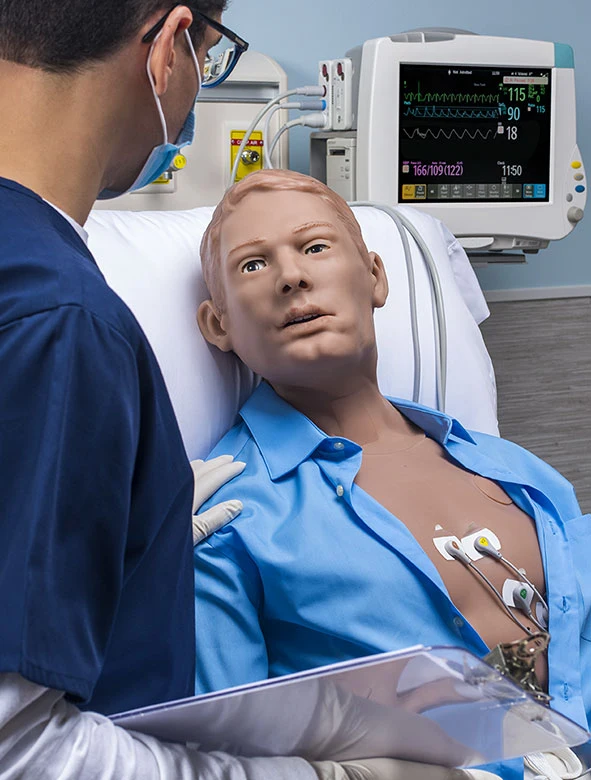
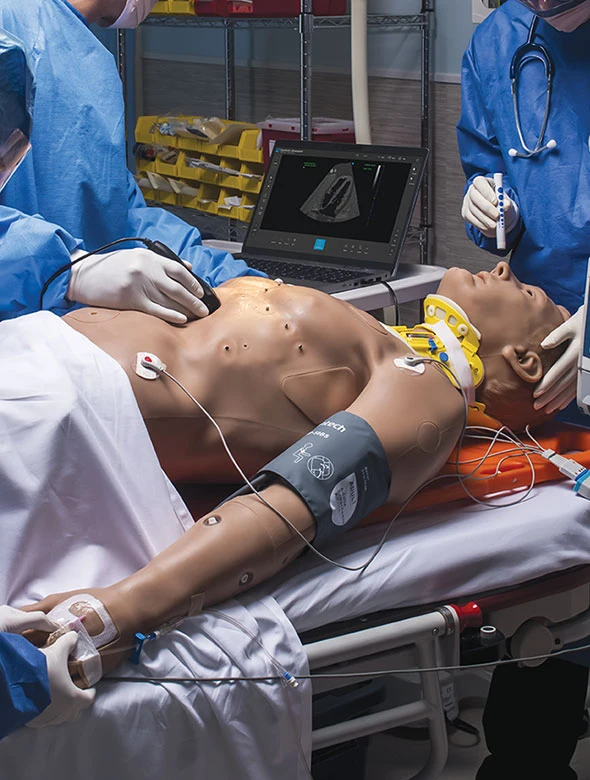
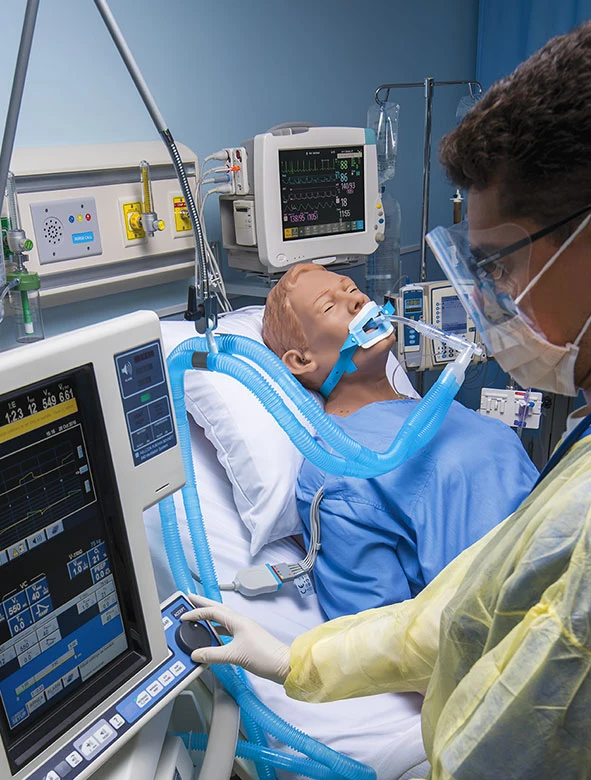
A new standard in patient care simulation
HAL S5301 is the all-new flagship of the HAL brand, trusted by simulation programs worldwide for its innovation, ease of use, and reliability. The S5301 sets the standard for the future of patient simulation, building upon the design philosophy established with the original HAL launched nearly two decades ago. Join us as we chart HAL’s course into the future.
General
- Anatomically accurate adult male proportions; height 5’ 9” / 175 cm
- Lifelike skin features palpable landmarks and seamless articulating joints: neck, jaw, shoulders, elbow, wrists, fingers, hips, knees, ankles
- Realistic articulation supports common patient positions: supine, prone, Fowler’s
- Wireless and tetherless; all features are fully operational during transport
- Internal rechargeable battery provides hours of tetherless operation
- Windows tablet PC preloaded with UNI® 3.0 Unified Simulator Control Software
- HAL S5301 Simulation Learning Experiences™ scenario package
- Supports Bluetooth, Gaumard RF, and wired connectivity
- Compatible with Gaumard Ultrasound™
- Compatible with Care in Motion™ audio & video debriefing system
- Available in light, medium, or dark skin tones at no extra charge
Neurologic
- Programmable blinking rate, pupil dilation, and eye movement
- Programmable consensual and nonconsensual pupillary response to light stimuli
- Normal and abnormal eye movements and conditions, including strabismus, ptosis, and more
- Interactive eyes can follow a moving object
- Gaumard Conversational Speech enhanced by artificial intelligence; HAL listens and automatically answers patient history and initial assessment-related questions
- Auto-generated, natural-sounding voice
- Scenario and patient profile-dependent responses
- Follows voice commands including lift arm, look left, look right, and squeeze hand
- Varies verbal responses consistent with level of consciousness and physiologic state
- Gaumard Speech Processing Model: learns and improves understanding and verbal responses over time
- Wireless streaming voice: be the voice of HAL and listen to participants’ responses in real-time
- Includes large library of high-quality, prerecorded English and Spanish responses
- Record and playback custom speech phrases in any language
- Active mouth movement synchronizes with voice: close, open, smile, unilateral lip droop, and lockjaw
- Active neck movement: rotation, flexion, extension, and reduced cervical movement
- Sound localization: HAL automatically turns head and eyes toward the provider speaking
- Active robotics simulate lifelike expressions; preset library includes left facial droop, right facial droop, pained, quizzical, scared, smiling
- Preprogrammed emotional states automatically express non-verbal cues: normal, worried, anxious, and lethargic
- Active right arm motor reflex: shake hand, squeeze hand, raise arm, withdrawal response, and abnormal posturing (decorticate/ decerebrate)
- Lifelike stroke clinical presentations include facial droop, weakness in the right arm, abnormal posturing, and pain response
- Programmable, automated pain response to pressure-sensitive sites: bilateral supraorbital notch, trapezius pinch (left shoulder), sternal rub, and right middle finger nailbed
- Supports Train of Four monitoring using real devices
- Lifelike partial tonic-clonic and non-tonic-clonic seizures
- Programmable sweating (diaphoresis) and tears
Breathing
- Lifelike, spontaneous breathing with selectable normal and abnormal patterns
- Four anterior and posterior lung auscultation fields; new lung sound library
- Programmable bilateral or unilateral chest rise
- Fully internal, patented dynamic lungs and airway support the use of real mechanical ventilators and standard patient circuits; no calibration, proprietary adapters, or external converter adjuncts required
- Supports standard mechanical ventilators and modes of ventilation including:
- Continuous mandatory ventilation (CMV), volume assist/control, pressure assist/control, pressure support ventilation (PSV), pressure or volume controlled synchronized intermittent mandatory ventilation (SIMV), continuous positive airway pressure (CPAP)
- Supports therapeutic levels of PEEP
- Programmable advanced airway and lung functions
- Variable lung unit compliance
- Variable bilateral and unilateral bronchi resistance
- Inspiratory effort and rate
- Respiratory drive
- Real CO2 exhalation
- Auto-PEEP
- Advanced respiratory effort simulation allows for lifelike weaning/liberation scenarios
- Supports mechanical ventilation while fully mobile
- Left hemo/pneumothorax site supports palpation, incision, chest tube insertion, chest tube placement detection, bleeding, and suture
- Needle thoracentesis site supports needle insertion, detects needle placement, and presents audible hiss
- Presents normal to abnormal capnography waveforms on real devices, including “shark fin” waveform
Circulatory
- Bilateral palpable pulses: carotid, brachial, radial, femoral, popliteal, pedal
- Pulse palpation detection and event logging
- Programmable circumoral skin coloration: cyanosis, redness, and pallor
- Programmable oxygen saturation; monitor using real pulse oximetry sensors on the left middle finger
- Supports non-invasive auscultatory and oscillometric blood pressure measurement with real monitors and devices
- Monitor intra-arterial blood pressure using real adjuncts, sensors, and devices
- Bilateral IV access sites support cannulation with flashback, infusion, and sampling
- Radial arterial access site supports catheterization, flashback, sampling, and IBP monitoring
- Antecubital vein blood draw site on left arm
- Automatic drug recognition detects virtual medications injected into the lower left arm
- Fingerstick glucose testing on the left index finger
- Tibia and humeral intraosseous access and infusion
- Programmable capillary refill time testing located on right middle finger
- Intramuscular injection site on left deltoid
Cardiac
- Aortic, pulmonic, tricuspid, and mitral auscultation fields and new heart sound library
- Supports 4-lead and 12-lead ECG monitoring using real monitoring devices
- Generate cardiac injury, ischemia, and necrosis using the UNI® 3D Myocardial Infarction Model; monitor resulting abnormal ECG rhythms on a real 12-lead ECG monitoring device
- Customize 12-lead waveforms with 12-lead ECG designer interface
- ECG-derived respiratory monitoring
- Supports standard defibrillation, double sequential defibrillation, cardioversion, and pacing with live energy
- Allows for anterior/lateral and anterior/posterior pad placement
- eCPR™ real-time quality feedback and reporting: Time to CPR, compression depth/rate, compression interruptions, ventilation rate, excessive ventilation, smart CPR coach
Genitourinary
- Male urinary catheterization with programmable fluid return
- Computer-controlled urinary output rate and urine and/or blood mixture
- Programmable urinary incontinence
- Internal, auto-refilling 0.7-liter urine reservoir
Gastrointestinal
- Male urinary catheterization with programmable fluid return
- Computer-controlled urinary output rate and urine and/or blood mixture
- Programmable urinary incontinence
- Internal, auto-refilling 0.7-liter urine reservoir
Trauma
- Internal, auto-refilling 1.2-liter blood reservoir
- Abdominal bleeding wound responds to pressure and packing
- Optional trauma arm and trauma leg accessories feature bleeding wound and tourniquet placement detection
- Computer-controlled blood pressure-dependent bleeding
Introducing a new level of fidelity in
neurological emergency simulation
HAL introduces the latest innovations in robotics simulate lifelike symptoms of a neurological emergency and enables team-based training through patient assessment and treatment. New features like facial droop, , and arm motor control reproduce the progression of a stroke, helping teams train in time-dependent clinical skills and teamwork.
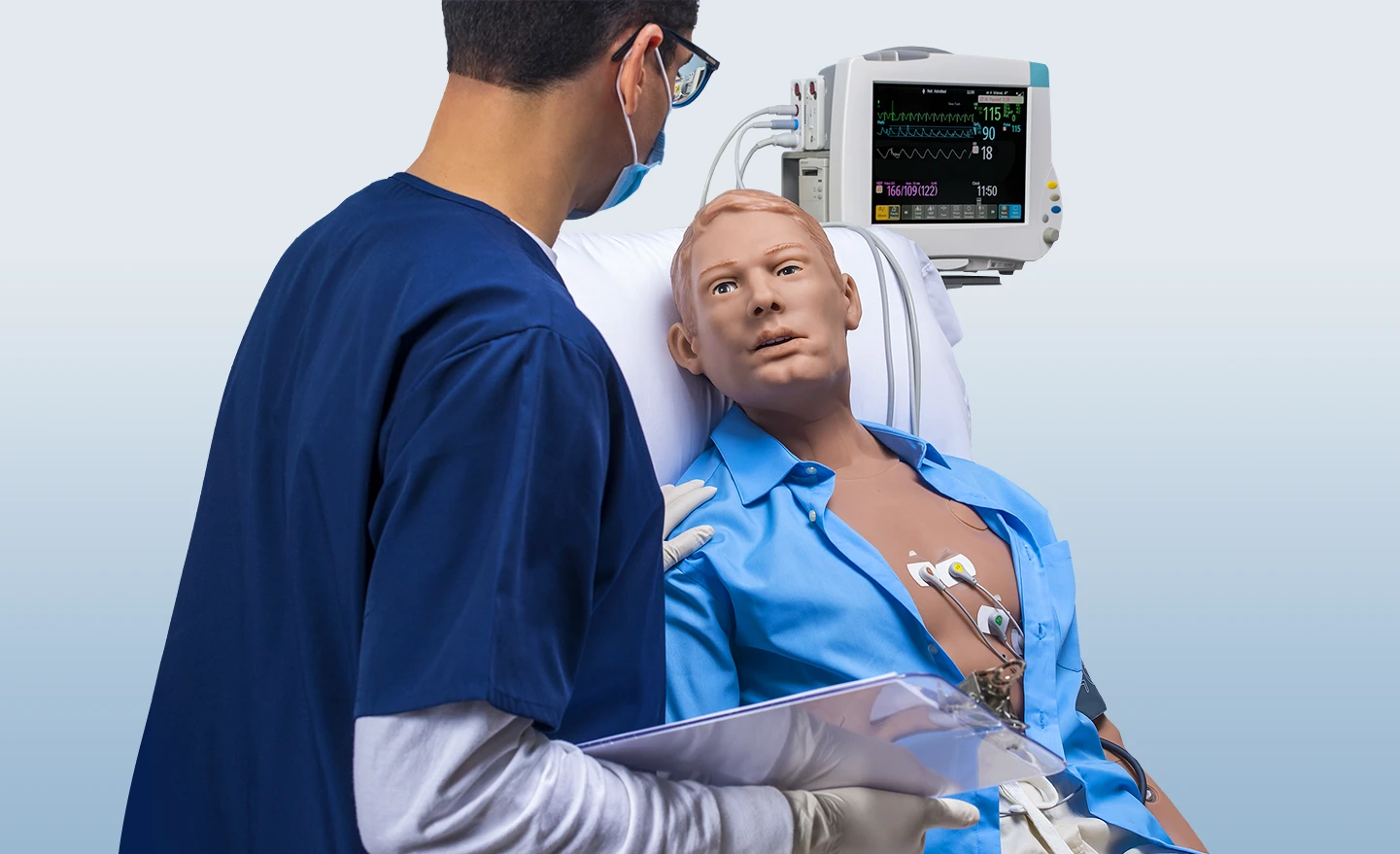


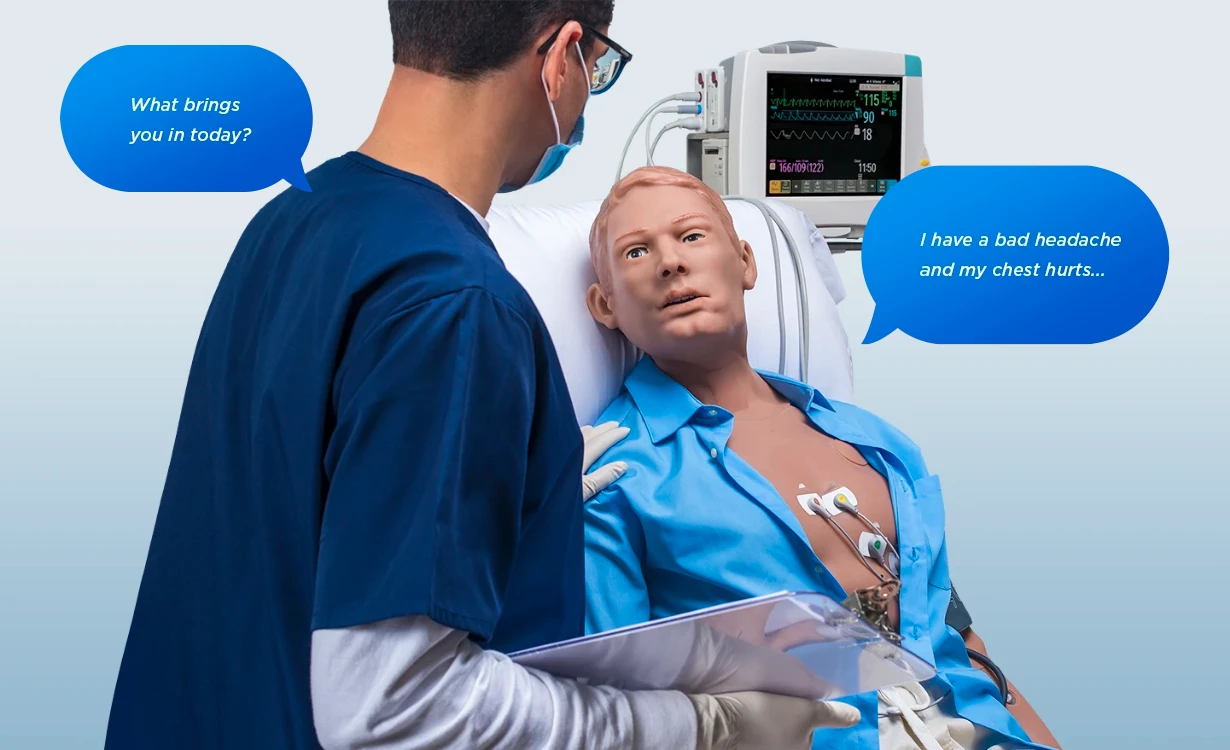
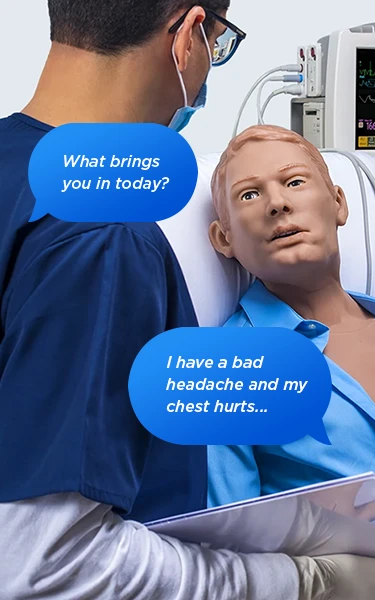
Active motor function
Right arm motor reflex: shake hand, squeeze hand, raise arm, withdrawal response, and abnormal posturing. Head and eyes turn toward the provider speaking.
Advanced physiology capable of simulating many clinical presentations
Active motor function
Right arm motor reflex: shake hand, squeeze hand, raise arm, withdrawal response, and abnormal posturing. Head and eyes turn toward the provider speaking.
Abnormal eye movements
Consensual and nonconsensual pupillary response to light stimuli. Abnormal eye movements include strabismus, ptosis, and more.
Dynamic facial expressions
Lifelike facial droop and smiling, pained, quizzical, and scared facial expressions. Dynamic emotional states automatically express non-verbal cues including worry, anxiety, and lethargy.
Lifelike sensory response
Active pain response to pressure-sensitive sites: bilateral supraorbital notch, trapezius pinch (left shoulder), sternal rub, and right middle finger nailbed.
Immersive training for your hospital trauma team
With new ultra-high fidelity anatomy and physiology, HAL supports advanced trauma care algorithms and essential surgical interventions using real tools and clinical techniques. Skin, bony landmarks, and internal tissue provide realistic tactile feedback to maximize the development of transferable skills. Internal sensors provide real-time feedback on provider interventions while automatically recording event data for debriefing.
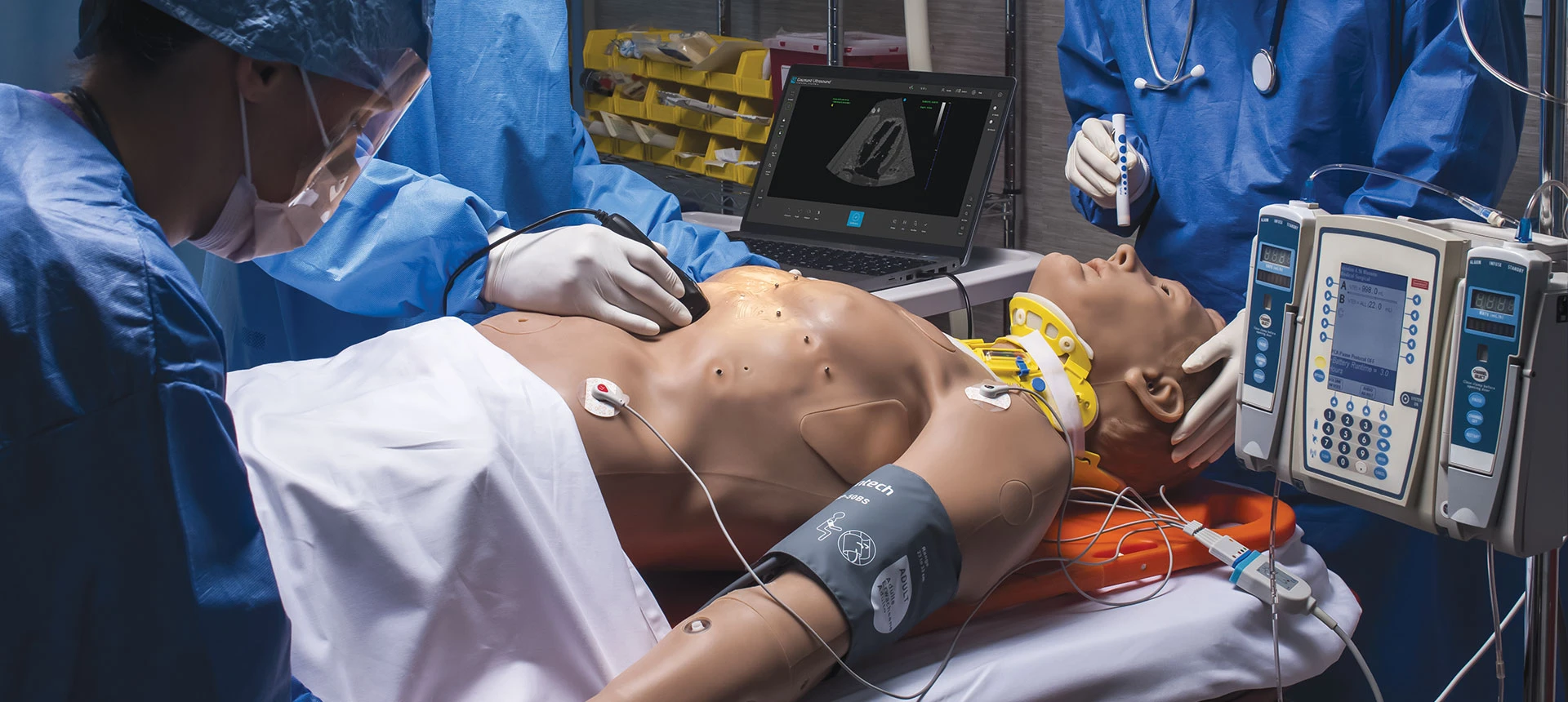
True-to-life imaging with Gaumard Ultrasound™
Facilitate ultrasound training through full-scale immersive emergency and trauma scenarios. Gaumard Ultrasound simulates the function and feel of a real portable ultrasound machine. Transducer range-of-motion and imaging is dynamic and lifelike, allowing students and professionals to refine imaging skills in team-based simulation. The new HAL Emergency POCUS/eFAST module offers you a library of emergency ultrasound case imaging covering a wide variety of trauma presentations.
Emergency Ultrasound
Case Imaging
- Healthy
- Left Pneumothorax
- Left Hemothorax
- Left Pleural Effusion
- Right Pneumothorax
- Right Hemothorax
- Right Pleural Effusion
- Splenic Hematoma
- Splenic Rupture with Blood in Rectovesical Pouch
- Liver Laceration
- Pericardial Effusion
- Pericardial Tamponade with Right Atrial Compression
- Pneumoperitoneum
- Appendicitis
- Bladder Rupture
- Cholecystitis
True-to-life imaging with Gaumard Ultrasound™
Facilitate ultrasound training through full-scale immersive emergency and trauma scenarios. Gaumard Ultrasound simulates the function and feel of a real portable ultrasound machine. Transducer range-of-motion and imaging is dynamic and lifelike, allowing students and professionals to refine imaging skills in team-based simulation. The new HAL Emergency POCUS/eFAST module offers you a library of emergency ultrasound case imaging covering a wide variety of trauma presentations.
Practice hands-on procedures using real tools and techniques
Chest tube thoracostomy
Realistic left hemo/pneumothorax site supports palpation, incision, chest tube insertion, tube placement detection, bleeding, and suturing.
Surgical airway management
Anatomically accurate oral cavity and airway. Perform tracheotomy, cricothyrotomy, and retrograde intubation.
Abdominal bleeding wound
Penetrating abdominal wound responds to pressure and packing. Features internal, auto-refilling blood reservoir with 1.2-liter capacity.
Intraosseous access
Supports tibia and humeral intraosseous access and continuous infusion.
Real-time CPR performance feedback
Real-time quality feedback and reporting: Time to CPR, compression depth/rate, compression interruptions, ventilation rate, excessive ventilation, smart CPR coach.
The new gold standard
for critical care in-situ simulation training
HAL S5301 revolutionizes critical care simulation training through powerful physiologic features and software. HAL helps participants improve skills and confidence by enabling learning experiences in real environments and using actual patient monitoring devices and mechanical ventilators.
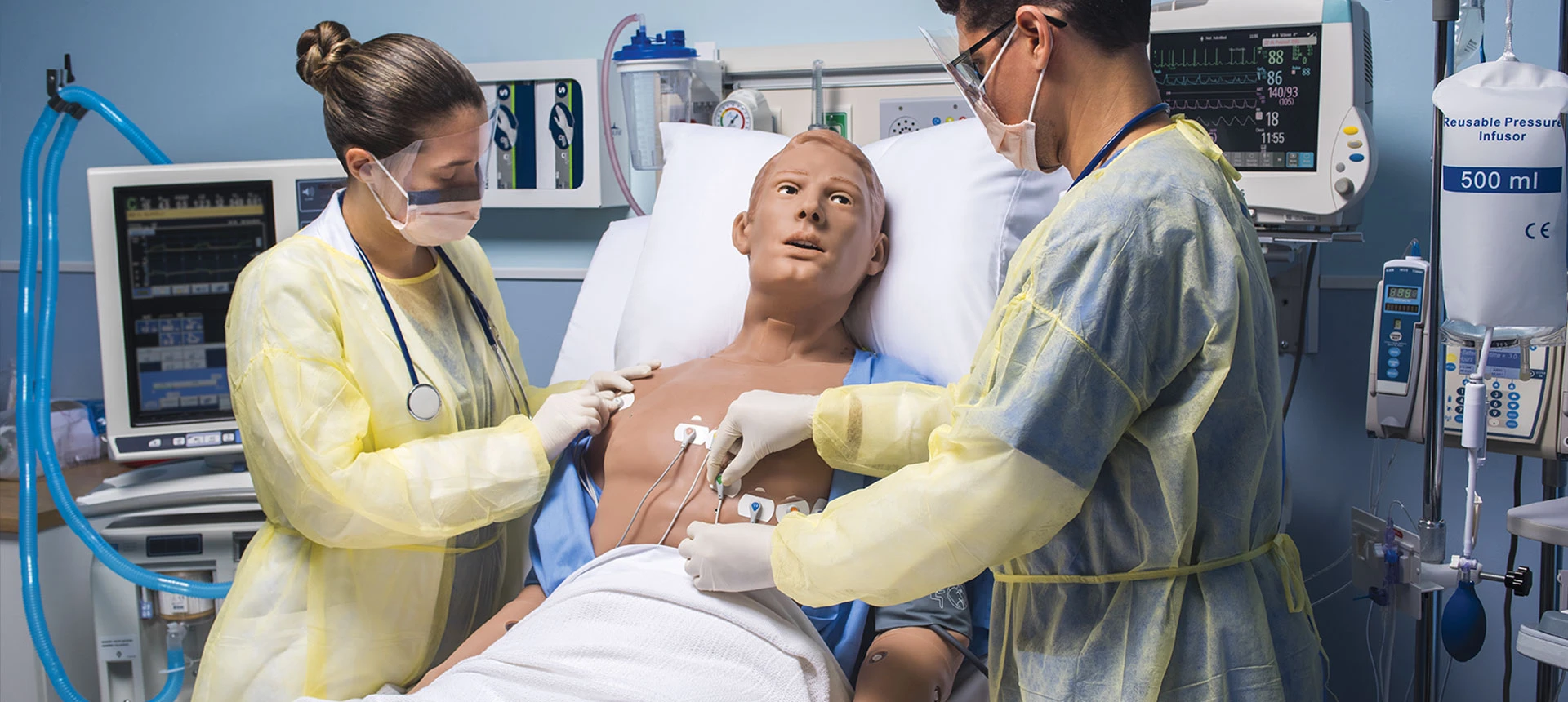
Next-generation lung physiology and mechanical ventilator support
HAL S5301 features our latest advanced dynamic lung system design, capable of responding to mechanical ventilation with greater physiologic accuracy. HAL interfaces with real mechanical ventilators like a real patient and supports standard ventilator modes, including AC, CMV, SIMV, and PSV, as well as PEEP and weaning strategies. The patented internal lung design means no manual calibration, proprietary adapters, or expensive and stationary external converters.
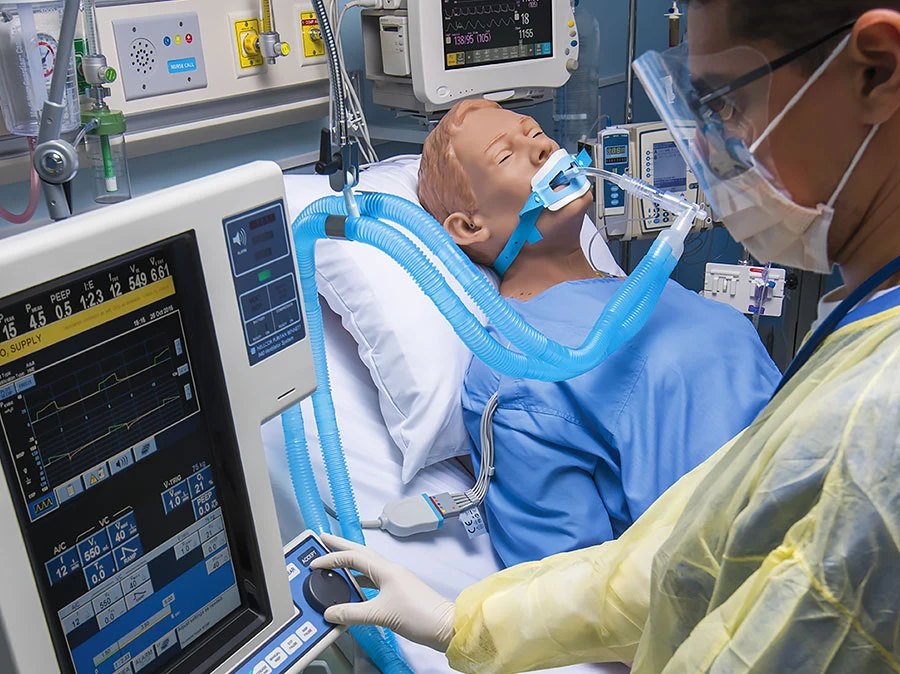
Next-generation lung physiology and mechanical ventilator support
HAL S5301 features our latest advanced dynamic lung system design, capable of responding to mechanical ventilation with greater physiologic accuracy. HAL interfaces with real mechanical ventilators like a real patient and supports standard ventilator modes, including AC, CMV, SIMV, and PSV, as well as PEEP and weaning strategies. The patented internal lung design means no manual calibration, proprietary adapters, or expensive and stationary external converters.
Develop vital sign assessment and management skills using real equipment
Real patient monitoring
Monitor vitals using real equipment: RR, 12-lead ECG, IBP, BP, SpO2, TOF, and EtCO2
High-quality auscultation
New, high-quality library of lung, heart, and bowel sounds. Anatomically accurate auscultation fields.
Intra-arterial blood pressure monitoring
Radial arterial access site permits catheterization, flashback, sampling, and IBP monitoring; interfaces with real adjuncts, sensors, and devices.
Intraosseous access
Features bilateral IV access sites, an antecubital vein blood draw site, and automatic virtual drug recognition on the lower left arm.
Blood glucose testing
Perform finger-stick glucose testing on the left index finger.
Train-of-Four monitoring
Supports Train-of-Four monitoring using real devices.
Deliver training experiences
reflective of diverse populations
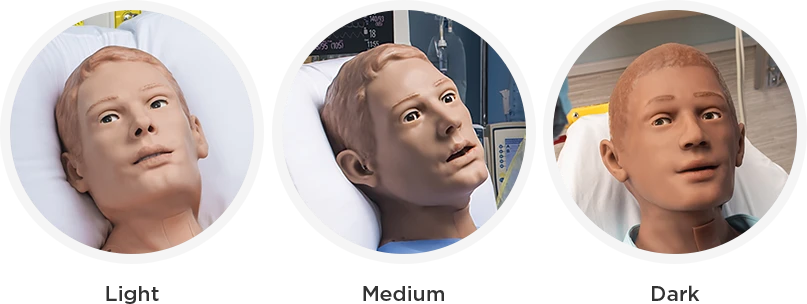
HAL S5301 makes it possible to deliver simulation experiences that more accurately reflect the diversity of the real world to promote bias-free patient care. Choose from three models at no additional charge.
Introducing the all-new
![]()
Unified Simulator Control Software
UNI 3 is our most powerful and intuitive patient simulator control software. Manage vitals, track performance, and debrief with faster and easier-to-use tools designed to help you navigate even the most complex scenarios with ease.

Built new from the ground up
UNI 3 is built on a new, modern software platform, improving performance and stability with a refreshed yet familiar design.
New controls and tools
User account management stores personalized settings, scenario builder features visual guides to aid planning, and new diagnostics tools that ensure HAL is always operating optimally.
Feedback for debriefing
UNI 3 interfaces with sensors in HAL to provide you with more detailed real-time performance and event data to aid assessment and debriefing.
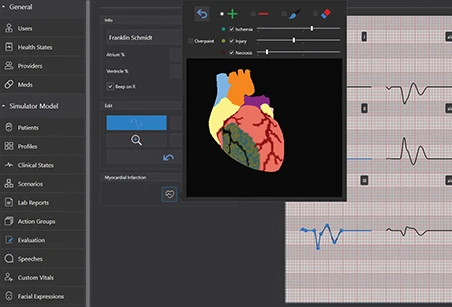
Myocardial infarction designer
Simulate a myocardial infarction with the easy-to-use 3D heart model and monitor the resulting changes using a real 12-lead ECG device or design your own rhythm using the point-by-point PQRST wave editor.

Patient profiles
The new Patient Chart lets you create simulated patients with detailed active and past medical histories. UNI seamlessly links medical chart data with Conversational Speech, enabling HAL to answer assessment and medical history questions automatically.

Scenario designer
Create scenarios tailored to your learning objectives and offer participants a wide range of standardized, repeatable learning events.
HAL® S5301 is ready for training with the Simulation Learning Experiences™ Package
The HAL S5301 Simulation Learning Experiences (SLE) package provides you with a library of ready-to-use, evidence-based scenarios designed to help reduce the facilitator’s workload, increase realism, and standardize training.
The package includes accompanying UNI® preprogrammed scenarios that automatically manage the patient’s vitals and a Facilitator’s Guide book with comprehensive information for planning, setting up, and facilitating each SLE.
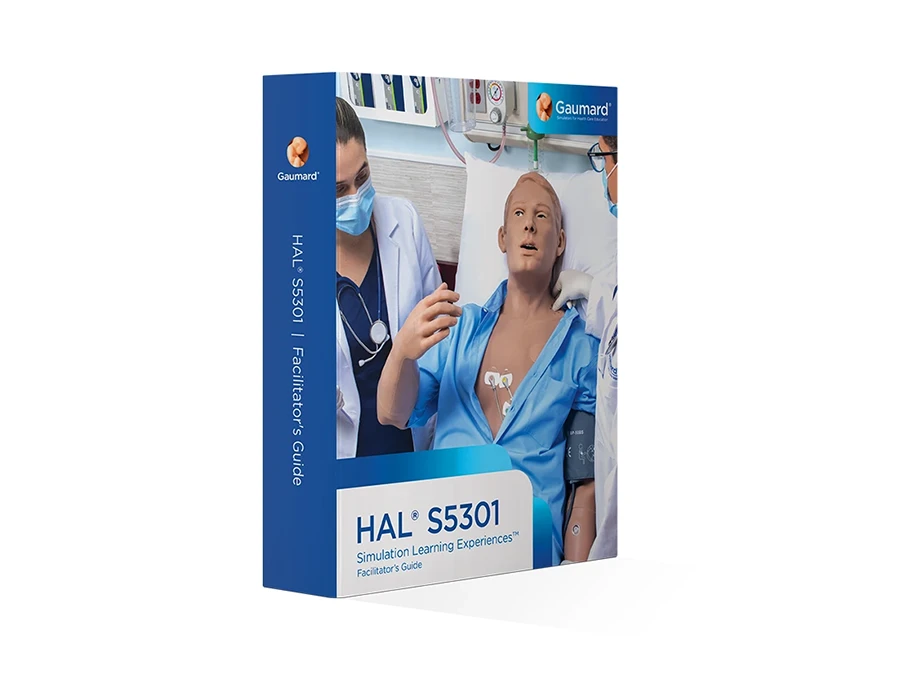
The HAL S5301 Simulation Learning Experiences (SLE) package provides you with a library of ready-to-use, evidence-based scenarios designed to help reduce the facilitator’s workload, increase realism, and standardize training.
The package includes accompanying UNI® preprogrammed scenarios that automatically manage the patient’s vitals and a Facilitator’s Guide book with comprehensive information for planning, setting up, and facilitating each SLE.
- Acute Cerebrovascular Accident / Stroke
- Adult Acute Abdomen
- Adult with Pulmonary Tuberculosis
- Adult with Pneumothorax related to Tuberculosis
- Acute Coronary Syndrome
- Acute Sepsis related to MRSA Infection
- Difficult Airway
- Gunshot Wound to the Abdomen
- Gunshot Wound - Postoperative
- Malignant Hyperthermia
- Multiple Trauma from an Industrial Accident
- Trauma related to Atrial Fibrillation
HAL® S5301
Interdisciplinary and Immersive
Package contents:
Accessories:
Gaumard Ultrasound™ System – 30081159A
Package includes Gaumard Ultrasound laptop, transducer, Gaumard Ultrasound software license, and transport case.
HAL® S5301 Emergency Ultrasound POCUS/eFAST Pathologies Module – 300811347B
HAL S5301 Emergency Ultrasound POCUS/eFAST Module software license for Gaumard Ultrasound.
CARE IN MOTION™ Mobile Video Debriefing System – CIM.PK
Care in Motion Tablet PC, 3 battery-powered HD wireless cameras, 3 adjustable camera grips, and a transport case. One-Year Limited Warranty.
Traumatic Right Arm Amputation – 30011856A
Lower-right arm with traumatic amputation and pressure-sensitive bleeding site.
Traumatic Left Leg Amputation – 30011859A
Lower-left leg with traumatic amputation and pressure-sensitive bleeding site.
Tech Support
Connect to a Gaumard
Representative
Download User Guides
Get the current User Guides
for your products
Gaumard Software
Download the latest software
and updates


